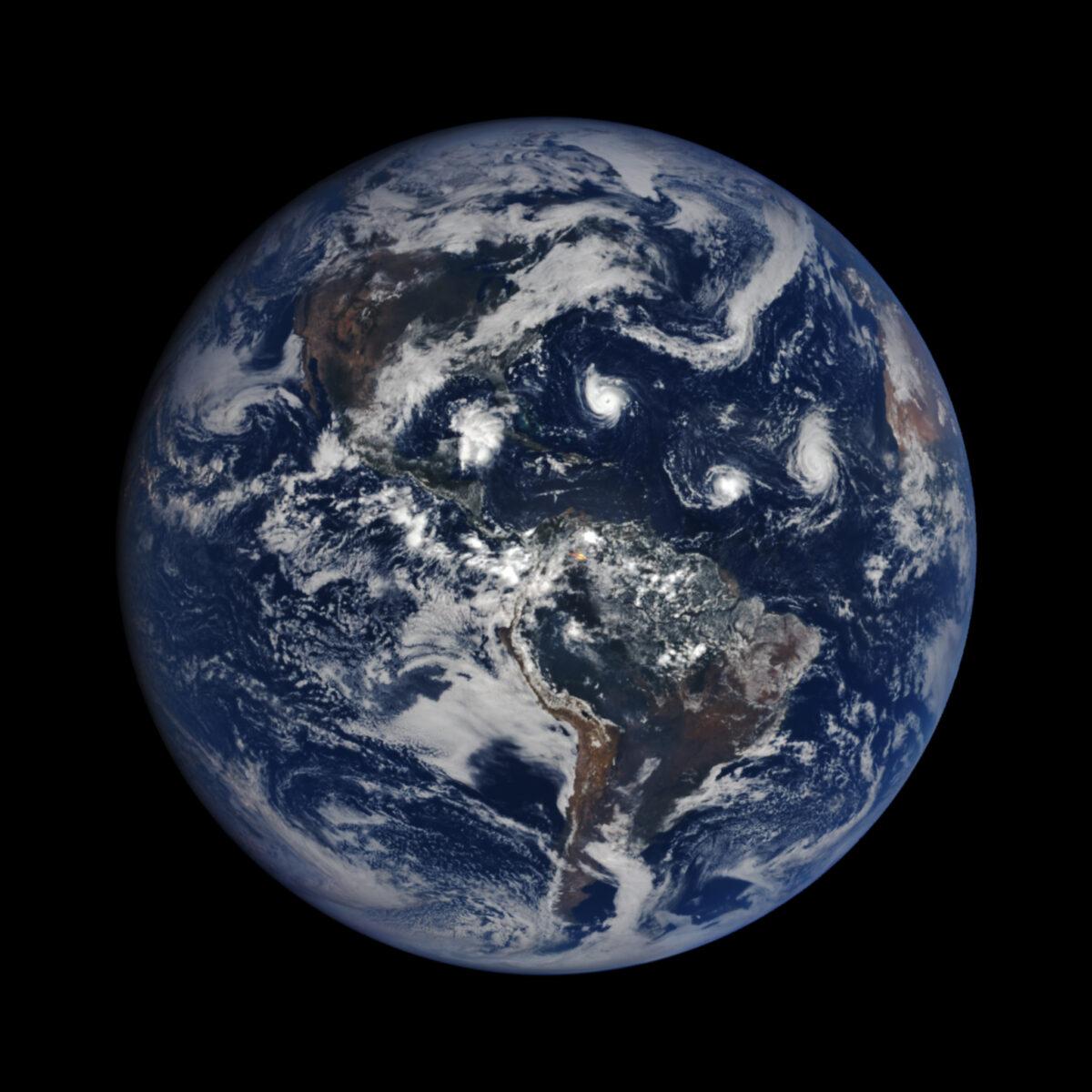Nobel Winner Refutes Climate Change Narrative, Points Out Ignored Factor

According to the Nobel laureate quoted below, the models used to predict global warming assume the world’s atmosphere has no clouds. But cloud cover over the oceans – which cover most of the planet – increases if temperatures rise, offsetting the warming effect of atmospheric carbon many fold.
This massive inaccuracy yields incorrect climate predictions. The Nobel winner continues, “This worry about CO2, the worry about methane, the worry about global warming, is all a total fabrication by shock journalists and/or dishonest politicians.”
NOTE: this article was originally published to TheEpochTimes.com on September 9, 2023. It was written by Jan Jekielek and Mimi Nguyen Ly.
Nobel Prize laureate John Clauser has recently been in the spotlight for challenging prevailing climate models, which he said have ignored a key variable.
The WCD highlights the limitations of current climate models, stating that they overemphasize the effects of greenhouse gases such as carbon dioxide (CO2).
The declaration further notes that both natural and human activities contribute to climate change and that the actual warming observed is less than as predicted by the climate models, revealing our incomplete understanding of climate change.
Clouds
Prominent climate reports, such as those by the Intergovernmental Panel on Climate Change (IPCC), National Academy of Sciences, and The Royal Society, emphasize the role of CO2 but miss the mark on the critical role of clouds in the climate system, according to Mr. Clauser.
His curiosity about clouds began when he was a sailboat racer.
Mr. Clauser said: “I raced across the Pacific Ocean at least a dozen times. I had set up the boat with solar panels to charge the batteries. … I had an ammeter on the power output from the solar panels, and I noticed every time we sailed under a cloud, the output from the solar panels dropped by 50 percent to half of its value that it was, and then we came out from behind the cloud and boom, their power went back up. And I thought, ‘I wonder why it’s just about a factor of two.’
“This is how I became very curious as to how clouds work. When the climate issues came along, I very quickly realized that cloud cover has a profound effect on the earth’s heat input that the clouds are reflecting a massive amount of light back out into space.
“And so I read all of the various IPCC reports, National Academy reports on this. As a physicist, I’d worked at some excellent institutions—Caltech, Columbia, Cal Berkeley—where very careful science needed to be done. And reading these reports, I was appalled at how sloppy the work was. And in particular, it was very obvious, even in the earliest reports, and all carried on through to the present, that clouds were not at all understood. … It’s just simply bad science.”
Mr. Clauser highlighted insights from former President Barack Obama’s science adviser, Steve Koonin. In Mr. Koonin’s book, “Unsettled: What Climate Science Tells Us, What It Doesn’t, and Why It Matters,” the author noted the inconsistency of the IPCC’s 40 computer models, emphasizing their inability to explain the past century’s climate and suggesting that these models lack a crucial piece of physics.

Clouds pictured in Guna Yala Comarca, Panama, near the island of Carti Sugtupu in the Caribbean Sea, on Aug. 28, 2023. (Luis Acosta/AFP via Getty Images)
‘The Missing Piece’
“I believe I have the missing piece of the puzzle that has been left out in virtually all of these computer programs,” Mr. Clauser said. “And that is the effect of clouds.”
Many theories of anthropogenic climate change naturally focus on the effects of human-produced CO2, but he said these models overlook the significance of cloud dynamics.
Mr. Clauser referenced the 2003 National Academy report, which he said “totally admitted” its lack of understanding about clouds and made “a whole series of mistaken statements regarding the effects of clouds.”
Referring to former Vice President Al Gore’s film, “An Inconvenient Truth,” Mr. Clauser said, “[Mr. Gore] insists on talking about a cloud-free Earth.” According to Mr. Clauser, this cloudless portrayal of the earth reflects the approach taken by many in the climate science community.
“That’s a totally artificial Earth,” he said. “It is a totally artificial case for using a model, and this is pretty much what the IPCC and others use—a cloud-free Earth.”
Mr. Clauser pointed out that satellite images consistently show wide variances in cloud cover, which can span anywhere from 5 to 95 percent of the Earth’s surface.
“The cloud cover fraction fluctuates quite dramatically on daily weekly timescales. We call this weather. You can’t have weather without having clouds,” he said.

A photo of planet Earth from NASA’s Earth Polychromatic Imaging Camera on the DSCOVR satellite on Sept. 11, 2018. (NASA Earth Observatory)
Effect of Clouds Compared With CO2
Clouds play a significant role in regulating the Earth’s temperature, serving as a “cloud-sunlight-reflectivity thermostat” that “controls the climate, controls the temperature of the Earth, and stabilizes it very powerfully and very dramatically,” according to Mr. Clauser.
Because they make up two-thirds of the Earth’s surface, oceans are instrumental in cloud formation, he said.
Minimal clouds result in heightened sunlight exposure to the ocean, triggering increased evaporation and subsequent cloud formation, resulting in more clouds. Abundant clouds reduce this sunlight, thus curbing evaporation rates and cloud formation, resulting in fewer clouds, according to Mr. Clauser.
This balance acts like a natural thermostat for the earth’s temperature, he said.
Mr. Clauser contends that this “thermostat” mechanism has a vastly greater influence on Earth’s temperature than the effect of CO2 or methane. He presented to The Epoch Times preliminary calculations that suggest that the effect of this cloud-reflectivity mechanism might overshadow CO2’s influence by 100 or even 200 times.
He said he finds it baffling that these significant variations, ranging from 5 to 95 percent cloud cover, have been overlooked.
Mr. Clauser also said clouds are integral to weather dynamics, yet current climate models, whose authors “admit up front that their models cannot predict weather,” have been wielded to foretell drastic climatic shifts, including “climate crisis apocalypse.”
The term “climate” refers to weather condition averages over the long term, usually at least 30 years. While reliable weather forecasts are limited to about a week with standard weather prediction models, which take into account the role of clouds, Mr. Clauser pointed out a contradiction noted in Mr. Koonin’s book: Just a 5 percent rise in cloud cover can largely counterbalance the temperature effect of doubling atmospheric CO2. Despite such nuances, the IPCC’s models persistently assume constant albedo and ignore the vast cloud cover variations, according to Mr. Clauser.
‘Very Dishonest Disinformation’
Mr. Clauser observed that the drive to address human-induced climate change is increasingly shaping political agendas and influencing the strategic direction of entire nations.
“The whole world is doing all of this. A lot of the pressure is actually coming from Europe, all of these various world conferences,” he said, speculating that much of this push might have its roots in Mr. Gore’s “An Inconvenient Truth,” which he feels has incorporated inaccurate science.
Mr. Gore’s film claims that humanity is triggering a dire climate crisis that necessitates global action. But Mr. Clauser said that “‘climate change’ is actually very dishonest disinformation that has been presented by various politicians.”
“The reason that was given was, ‘Well, because it’s really more than just warming,'” he said. The article champions a “U.S. Climate Extremes Index,” claiming that anthropogenic climate change led to a significant increase in extreme weather events over the three decades ending in 2012.
The index is supposedly backed by a century’s worth of data from the National Oceanographic and Atmospheric Association (NOAA) and is said to combine various metrics, including floods, hurricanes, and droughts.
Curiously, Mr. Clauser noted, the index leaves out the frequency of EF3-plus tornadoes—perhaps because, as highlighted by Mr. Koonin in his book, those were on a noticeable decline.
“This, in my opinion, is a rather egregious breach of honesty by the U.S. government by NOAA,” Mr. Clauser said.
He used data from the article and plotted it chronologically and also in reverse. He observed that the two plots were virtually indistinguishable, challenging the assertion of an obvious rise in the index.
“Are you really willing to bet trillions of dollars that you know which [plot] is right? … Is it really increasing? It is clearly not,” Mr. Clauser said.
“Not only, as I understand it, are these extreme weather events not increasing, but our ability to mitigate them has increased. So they’re just not as much of an issue.
“This worry about CO2, the worry about methane, the worry about global warming, is all a total fabrication by shock journalists and/or dishonest politicians.”
“Historically, for example, when dinosaurs roamed the earth, the CO2 levels were 10 times bigger than what we are experiencing right now,” Mr. Clauser said. “Dinosaurs couldn’t have survived on this earth with this low CO2 level [today], because you don’t grow trees fast enough and foliage fast enough to feed them.
“Promoting CO2 as being actually a beneficial gas, as far as I can tell, there’s nothing wrong with [that]. And in particular, as I have just mentioned earlier, it is not at all significant in controlling the earth’s climate.”
He criticized U.S. government efforts to reduce CO2 and methane as a colossal misuse of resources better allocated for humanitarian endeavors. Such initiatives “should be stopped immediately,” he said.
“[It’s] a total waste of money and time and effort. It is strangling industry,” Mr. Clauser said.
But he said he isn’t holding his breath.
“My suspicion is what I am saying here will be totally ignored because people don’t like being told that they’ve made big mistakes of this magnitude,” Mr. Clauser said.
—
For more posts like this, in your inbox weekly – sign up for the Restoring Diversity Newsletter
